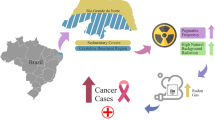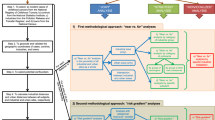Abstract
Cancer has long been known to be a hazard of exposure to ionizing radiation. However, the assessment of health effects from exposure to radiation is a matter of considerable controversy. This paper presents results of a retrospective study of leukemia incidence (203–207, ICD-9) around the highest 137Cs pollution in Poland (as an effect of the Czarnobyl disaster and/or military bomb tests). The data relating to all the registered leukemias in males and females originated from the Regional Cancer Registry in Opole. The information on 137Cs concentration rates in Opole province was derived from the state monitoring provided by the Polish Geological Institute in Warsaw. The spatial analysis – based on the random-effects Poisson regression model – was carried out via the Markov Chain Monte Carlo (MCMC) technique (Gibbs sampling) using BUGS software. The model incorporated epidemiological data and an ecological covariate – isotope concentrations – and provided a framework for estimating the strength of a dose–response relationship. The differences in incidence levels were quantified by traditional standardized morbidity ratios (SMRs) and presented in thematic maps as well as in combined charts of distance–disease–dose relations. Additionally, to assess spatial disease clustering, a Tango test was adopted. The results of this ecological study suggest that the 137Cs concentrations did not have any negative influence on the exposed population.
Similar content being viewed by others
References
Medical Research Council (1956) The Hazards to Man of Nuclear and Allied Radiations. London: HMSO, Cmd. 9780.
Darby SC, Reissland JA (1981) Low levels of ionizing radiation and cancer — are we underestimating the risk? J R Stat Soc A, 144: 298–331 (with discussion).
Mancuso TF, Stewart A, Kneale G (1977) Radiation exposures of Hanford workers dying from cancer and other causes. Health Phys 33: 369–385.
Darby SC, Doll R (1987) Fallout, radiation doses near Dounrey, and childhood leukaemia. BMJ 294: 603–607.
Gilks WR, Thomas A, Spiegelhalter DJ (1994) A language and program for complex Bayesian modeling. Statistician 43: 169–177.
Spiegelhalter D, Thomas A, Best N, Gilks W (2000) BUGS: Bayesian Inference Using Gibbs Sampling, Version 1.3. Cambridge: Medical Research Council Biostatistics Unit, http://www.mrcbsu.cam.ac.uk/bugs/.
Spiegelhalter D, Thomas A, Best N, Gilks W (1996) BUGS 0.5 Examples, Vol. 2. Cambridge: Medical Research Council Biostatistics Unit, pp. 37–42, http://www.mrc-bsu.cam.ac.uk/bugs/.
Tango T (1995) A class of tests for detecting “general” and “focused” clustering of rare disease, Stat Med 14: 2323–2334.
Strzelecki R, Wolkowicz S, Szewezyk J, Lewandowski P (1993) Radioecological Maps of Poland, Part I and II. Warszawa: Polish Geological Institute.
Wakeford R, Binks K, Wilkie D (1989) Childhood leukaemia and nuclear installations. J R Stat Soc A, 152: 61–86.
Wheldon TE (1989) The assessments of risk of radiation-induced childhood leukaemia in the vicinity of nuclear installations. J R Stat Soc A, 152: 327–339.
Parkin DM, Muir CS, Whelan SL, Gao Y-T, Ferlay J, Powell J, eds (1992) Cancer Incidence in Five Continents. Lyon: IARC Scientific Publications, VI, 120: 690–693.
Tukiendorf A, Drosik K, Michalski A, Wasielewski M (1997) Cancer in Opole Province in the Years 1985–1993, Part I: Atlas of Incidence. Opole: Opole University, pp. 10–11.
Darby SC (1985) Evaluation of radiation risk from epidemiological studies of populations exposed at high doses. Statistican 1985; 34: 59–72.
Hoffmann W, Schlattmann P (1999) An analysis of the geographical distribution of leukaemia incidence in the vicinity of a suspected point source: a case study. In: Lawson A, Biggeri A, Böhning D, Lesaffre E, Viel J-F, Bertollini R, eds. Disease Mapping and Risk Assessment for Public Health, Chichester: Wiley, pp. 395–409.
Keckler, D (1995) SURFER for Windows, User's Guide, Golden, CO: Golden Software, Inc., chapter 5–32.
Smith AFM, Roberts GO (1993) Bayesian computation via the Gibbs sampler and related Markov chain Monte Carlo methods. J R Stat Soc B, 55: 3–23.
Gardner MJ (1989) Review of reported increases of childhood cancer rates in the vicinity of nuclear installations in the UK. J R Stat Soc A, 152: 307–325.
Author information
Authors and Affiliations
Rights and permissions
About this article
Cite this article
Tukiendorf, A. An ecological analysis of leukemia incidence around the highest 137Cs concentration in Poland. Cancer Causes Control 12, 653–659 (2001). https://doi.org/10.1023/A:1011293224832
Issue Date:
DOI: https://doi.org/10.1023/A:1011293224832




